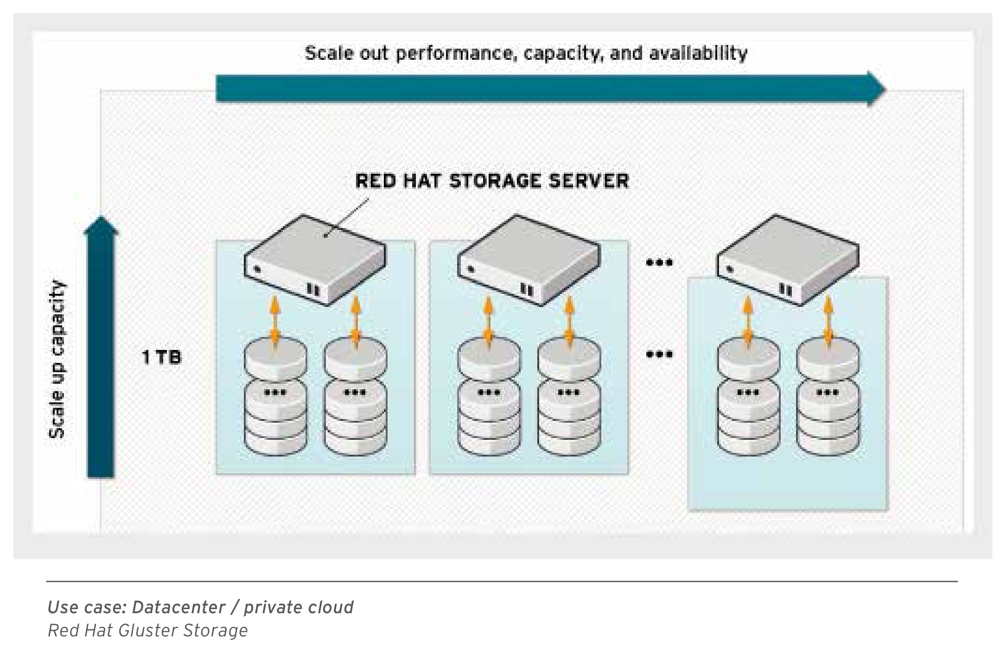Red Hat Gluster Storage 3.2
Software-defined storage solution includes enhancements and features to improve small file performance, provide data integrity, enhance integration with OpenShift ContainerPlatform
This is a Press Release edited by StorageNewsletter.com on March 31, 2017 at 3:15 pmRed Hat, Inc. announced the availability of Gluster Storage 3.2.

This version of the company’s software-defined storage solution includes a number of enhancements and features that seek to improve small file performance, provide data integrity at a lower cost, and enhance integration with OpenShift Container Platform.
Gluster Storage 3.2 addresses an inherent challenge with NAS around scaling metadata-intensive operations, particularly with files under a few megabytes. These improvements to metadata operations can benefit storage of OpenShift Container Platform registries. Container registries, the heart of a container platform, are critical to resident applications and need highly elastic, durable storage. In addition, faster metadata-intensive operations can improve day-to-day operations by as much as 8x according to firm’s performance data, increasing the responsiveness of the storage system at scale and improving the overall end-user experience.
Gluster Storage 3.2 introduces additional capabilities and improvements:
-
Deeper integration with OpenShift Container Platform, adding native support for advanced storage services such as geo-replication and in-flight encryption for applications deployed in containers. These enhancements, packaged into the refreshed docker container image that is shipped with the latest release of the product, can also enable three times as many persistent volumes (PVs) per cluster according to quality engineering testing done by the company.
-
Smaller hardware footprint through arbiter volumes, which can shrink infrastructure costs while maintaining the same level of data integrity. Arbiter volumes can resolve conflicts in the event of data mismatch between two nodes without requiring a third copy of the data. Customers running traditional NAS use cases such as backup/restore can achieve the data integrity offered by three-way replication without incurring the associated cost of hardware, datacenter space, and power. This can be particularly advantageous to customers running hyperconverged configurations in ROBO scenarios.
-
Faster self-healing of erasure coded volumes can minimize performance impact during repair and healing operations. In addition, enhancements to self-healing operations can benefit customers who have deployed Gluster Storage with the company’s Virtualization to store VM images.
-
Enhanced monitoring capabilities enabled through native, asynchronous notifications help to improve day-to-day storage management. In addition, Gluster Storage offers extensibility through the Nagios Enterprises LLC‘ open source monitoring framework to enhance storage operations management.
Ranga Rangachari, VP and GM, storage, Red Hat, said: “Modern enterprises tend to think about software-defined storage in terms of enabling their business initiatives through digital transformation. It is a key enabler in the journey to the open hybrid cloud. Red Hat Gluster Storage 3.2 marks a milestone in the life of the product. It brings together a number of innovations that are relevant to the modern CIO.”
Nathan Huber, enterprise architect, Brinker International, Inc., said: “Red Hat was instrumental in our effort to re-platform the Chili’s Grill & Bar primary e-commerce website supporting online orders. Despite higher than usual web traffic on a recent holiday, the scale and performance of Red Hat Gluster Storage helped us to surpass our revenue goals and availability metrics for our web applications deployed on containers. Red Hat’s efforts to containerize enterprise storage enabled us to build a durable, more secure, multi-tiered environment using open source components.“
Laura DuBois, VP, enterprise storage, servers and infrastructure software, IDC, said: “This new release of Red Hat Gluster Storage becomes available as the software-defined storage industry is at an inflection point in terms of disrupting the way storage is consumed by data-driven enterprises. The flexibility of deployment across VMs, containers, and the public cloud gives Red Hat Gluster Storage an edge compared to traditional, monolithic storage appliances.“
Jim Elliott, VP, memory marketing, Samsung Semiconductor, Inc., said: “We are delighted to continue to expand our collaboration with Red Hat in the enterprise space to enhance the performance of Red Hat Gluster Storage using our NVMe SSDs. Customers looking to run IO-intensive, high-performance workloads on open source and software-defined NAS such as Red Hat Gluster Storage, can benefit greatly from our cooperative efforts to improve performance.“
Resources:












 Subscribe to our free daily newsletter
Subscribe to our free daily newsletter
